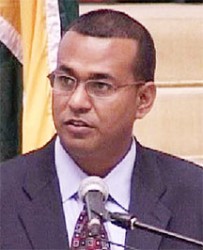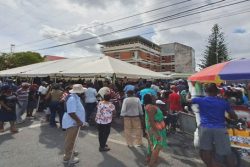Guyana will lose out on around US$20M of the payment it would have received under its forest protection agreement with Norway for last year, once increased deforestation is confirmed by independent verification exercises to be completed by month end, according to Natural Resources Minister Robert Persaud.
The figures, contained in the third Report on deforestation rates for the year 2012, compiled by the Guyana Forestry Commis-sion (GFC) and the forestry consulting firm Indufur, showed that Guyana’s deforestation rate has jumped to 0.079% in the Year 3 reporting period (2012), from 0.054% in the Year 2 reporting period (2011).
The Report was completed under the Monitoring Reporting and Verification (MRV) system for REDD+ and it summarises forest change of forest to non-forest.

Despite the increased deforestation rate, Persaud yesterday told a press conference that Guyana still has one of the lowest deforestation rates in South America and the world over. The minister also noted that although the increased figures have been recorded, no action can or will be taken on those figures until they are verified.
Currently, the University of Dunham is carrying out an independent verification exercise on the figures, and it is expected that it will complete its work by the end of the month. In addition, stakeholders’ views are currently being solicited, and a final report, which will include the feedback received, will be prepared subsequently.
Persaud also said that Norway will be commissioning its own verification exercise in its effort to ascertain the validity of the figures. This exercise is also expected to be completed by the end of the month. He said that the information captured in the preliminary report was done using 5 Meter Resolution Satellite Imagery, as opposed to the 30 Meter Resolution previously used.
The figures are therefore expected to be quite accurate and so it is likely that the results of the verification exercises will not be dramatically different, although the possibility exists that differing values can be arrived at.
Nevertheless, if the figures are found to be valid, Guyana may lose out on approximately 45% of the funds it was to earn from Norway under the Joint Concept Note (JCN) for 2012.
For the Year 2 period (2011), Guyana received US$45 million, but according to the JCN signed by the two countries, compensation for maintaining Guyana’s forests is results-based, and so as deforestation levels increase, the money Guyana will receive decreases.
The JCN states that a deforestation rate of 0.07% Guyana’s funds would be cut by 25%; at a deforestation rate of 0.08% the funding would be cut by 45%; at a deforestation rate of 0.09% the funding would be cut by 70%; and if Guyana’s deforestation reached 0.1% no payments would be made.
Last week, Dr. David Singh, who heads Conservation International said, “I do believe that there is going to be a significant reduction (of funds from Norway) as a result of this,” when contacted on the latest figures.
Deforestation drivers
Persaud attributed the increased deforestation primarily to mining and mining-related actives. His statements were in keeping with the Report, which said that 93% of the deforestation in 2011 was caused by mining. This, he said, continues to be the case in year 3 (2012), with the area of deforestation attributed to mining increasing to around 13,516 hectares from 9,891 hectares. This is from 18.5 million hectares of total forest, of which approximately 12.2 million hectares are being managed more effectively by the state, Persaud said.
Despite turbulent gold prices on the world market, the “gold boom” is very much alive and yesterday the President of the Guyana Gold and Diamond Miners Associa-tion (GGDMA) Patrick Harding said that gold declaration so far for 2013 stands at 415, 000 ounces. For the same period last year, gold declaration stood at 349,000 ounces.
Persaud also noted that gold amounted to 50% of Guyana’s exports for 2012, earning around US$716 million, while bauxite amounted to about 10%. Mining contributes significantly to Guyana’s Gross Domestic Product (GDP) and so Persaud was of the opinion that no one should be surprised that deforestation, as a result of increased mining, has taken place.
He added that the increase does not indicate that lawlessness is taking place in the mining sector. Instead, he explained, the increased scale has taken place in accordance with the stipulations and regulations laid down by the Ministry, the Guyana Geology and Mines Commission (GGMC) and the GFC.
While noting the increase in deforestation and indicating his concern about the increased rate, Harding nevertheless said that it is impossible for mining to continue and to flourish, without having some amount of deforestation take place.
He pointed out that beside revenue, mining creates a plethora of jobs and also necessitates the construction of infrastructure which can be and is used both mining and non-mining purposes.
He also reiterated his commitment towards working with the ministry and the GGMC to take whatever steps are necessary towards keeping deforestation levels in line with the agreement struck between Guyana and Norway.
Farming and other activities, such as the infrastructural work for the Amaila Falls Hydropower Project, were also cited as drivers of deforestation in 2012.





